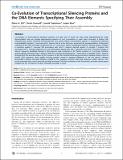| dc.contributor.author | Zill, Oliver A. | |
| dc.contributor.author | Scannell, Devin | |
| dc.contributor.author | Teytelman, Leonid | |
| dc.contributor.author | Rine, Jasper | |
| dc.date.accessioned | 2011-06-09T14:35:55Z | |
| dc.date.available | 2011-06-09T14:35:55Z | |
| dc.date.issued | 2010-11 | |
| dc.date.submitted | 2010-02 | |
| dc.identifier.issn | 1544-9173 | |
| dc.identifier.issn | 1545-7885 | |
| dc.identifier.uri | http://hdl.handle.net/1721.1/63599 | |
| dc.description.abstract | Co-evolution of transcriptional regulatory proteins and their sites of action has been often hypothesized but rarely demonstrated. Here we provide experimental evidence of such co-evolution in yeast silent chromatin, a finding that emerged from studies of hybrids formed between two closely related Saccharomyces species. A unidirectional silencing incompatibility between S. cerevisiae and S. bayanus led to a key discovery: asymmetrical complementation of divergent orthologs of the silent chromatin component Sir4. In S. cerevisiae/S. bayanus interspecies hybrids, ChIP-Seq analysis revealed a restriction against S. cerevisiae Sir4 associating with most S. bayanus silenced regions; in contrast, S. bayanus Sir4 associated with S. cerevisiae silenced loci to an even greater degree than did S. cerevisiae's own Sir4. Functional changes in silencer sequences paralleled changes in Sir4 sequence and a reduction in Sir1 family members in S. cerevisiae. Critically, species-specific silencing of the S. bayanus HMR locus could be reconstituted in S. cerevisiae by co-transfer of the S. bayanus Sir4 and Kos3 (the ancestral relative of Sir1) proteins. As Sir1/Kos3 and Sir4 bind conserved silencer-binding proteins, but not specific DNA sequences, these rapidly evolving proteins served to interpret differences in the two species' silencers presumably involving emergent features created by the regulatory proteins that bind sequences within silencers. The results presented here, and in particular the high resolution ChIP-Seq localization of the Sir4 protein, provided unanticipated insights into the mechanism of silent chromatin assembly in yeast. | en_US |
| dc.description.sponsorship | National Science Foundation (U.S.) (GM31105) | en_US |
| dc.description.sponsorship | National Science Foundation (U.S.) (Predoctoral Fellowships ) | en_US |
| dc.language.iso | en_US | |
| dc.publisher | Public Library of Science | en_US |
| dc.relation.isversionof | http://dx.doi.org/10.1371/journal.pbio.1000550 | en_US |
| dc.rights | Creative Commons Attribution | en_US |
| dc.rights.uri | http://creativecommons.org/licenses/by/2.5/ | en_US |
| dc.source | PLoS | en_US |
| dc.title | Co-Evolution of Transcriptional Silencing Proteins and the DNA Elements Specifying Their Assembly | en_US |
| dc.type | Article | en_US |
| dc.identifier.citation | Zill, Oliver A. et al.2010 "Co-Evolution of Transcriptional Silencing Proteins and the DNA Elements Specifying Their Assembly." PLoS Biol 8(11): e1000550. | en_US |
| dc.contributor.department | Massachusetts Institute of Technology. Materials Processing Center | en_US |
| dc.contributor.department | Massachusetts Institute of Technology. Department of Biology | en_US |
| dc.contributor.approver | Teytelman, Leonid | |
| dc.contributor.mitauthor | Teytelman, Leonid | |
| dc.relation.journal | PLoS Biology | en_US |
| dc.eprint.version | Final published version | en_US |
| dc.type.uri | http://purl.org/eprint/type/JournalArticle | en_US |
| eprint.status | http://purl.org/eprint/status/PeerReviewed | en_US |
| dspace.orderedauthors | Zill, Oliver A.; Scannell, Devin; Teytelman, Leonid; Rine, Jasper | en |
| mit.license | PUBLISHER_CC | en_US |
| mit.metadata.status | Complete | |
